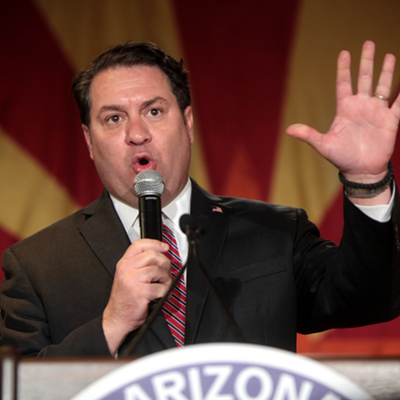Douglas R. Nickel, who'll start his new job as director and as UA tenured professor of art history in August, has been curator of photography at the San Francisco Museum of Modern Art since 1997. He has racked up an impressive array of exhibitions at SFMOMA, including last year's well-regarded Dreaming in Pictures: The Photography of Lewis Carroll and a 1999 show on Western photographer Carleton Watkins. Nickel has a doctorate in the history of photography from Princeton, and a bachelor's in art history from Cornell. A writer whose book on Victorian photographer Francis Frith will be published this fall, he has also taught as an adjunct prof at UC Berkeley and Stanford.
What remains to be seen is how this scholar/curator will fare in the vicious administrative warfare that has grievously wounded the center in recent years. Carla Stoffle, the UA dean of libraries, has conducted an unrelenting assault on the center's professional staff, first firing former director Terry Pitts three years ago. In the years since, unable to tolerate the stifling Stoffle regime, a steady stream of photography pros have left in his wake. The internationally renowned center, a treasure house of archives of leading 20th century photographers, has been without a director, a curator, a registrar or a full-time librarian for years.
In a desperate counter move, the staff tried to have the center removed from Stoffle's dictatorial control. Provost Paul Sypherd championed their cause a while back and wrote to President Peter Likins that Stoffle's management was seriously damaging the center. Particularly pernicious, Sypherd wrote, are her endless "total quality management" meetings that pull highly trained professionals away from their scholarly work for hours on end. And, ironically, Stoffle, a librarian, had seriously damaged the center's excellent photography library by depriving it of a full-time professional.
But former UA President John P. Schaefer, who helped found the Center with Ansel Adams back in 1975, allied himself with Stoffle against the professional staff. Likins had no wish to alienate the influential Schaefer, president of Research Corp., which funds grants to university professors. Likins directed his next provost, George Davis, to come up with a report more to Likins' liking. Davis readily complied and the Stoffle assault on the center continued.
Whether the new Nickel has the administrative chops to negotiate these mine fields is yet to be seen. He's already raised one red flag. In an interview in Sunday's Arizona Daily Star, Nickel said he's considering reducing the center's ambitious exhibition program from five shows a year down to one show every year and a half. Such a switch would put him firmly in the camp of Schaefer, who routinely rails against the center's exhibitions of contemporary photographers. But here's hoping that Schaefer and Stoffle will back off and allow their new guy some independence.
ODDS ON THE ODD: Democrat Ward 4 Councilwoman Shirley Scott looks like she's going to win the endorsement of the National Rifle Association in her re-election bid, which is going to make life even harder for Republican Mike Jenkins, a former legislative candidate who wants to challenge Scott in November.
Jenkins leans pretty far to the right, which makes victory unlikely in the first place, given that Democrats still outnumber Republicans in Tucson by a 3-2 margin. The Republicans who have won citywide--Bob Walkup, Fred Ronstadt and Kathleen Dunbar--have packaged themselves as moderates, which Jenkins is unlikely to do. And he'll have a hard time trying to convince those with checkbooks that a conservative can win.
Meanwhile, it appears that the GOP is going to take a dive on opposing Democrat Carol West, who faces a primary from political neophyte Lianda Ludwig. We hear Ronstadt, who's tight with West, convinced GOP county chairman John Munger to lay off. They could be screwing themselves if West gets knocked off in the primary, but nobody ever said these guys were political geniuses.
That leaves Ward 1, where incumbent Democrat José Ibarra is facing a challenge from Republican Armando Rios, whose claim to fame is being the business manager for basketball star Sean Elliott.
If Rios misses, former Mayor Tom Volgy defeats incumbent Mayor Bob Walkup and West goes down in her primary, the Repubs and their allies will have blown it all the way.
Here's a hint: Politics are a gamble. You improve the odds by playing more games.
CITY LIMITS: City Manager James Keene has cooked up suggestions for changing the state's annexation laws, which have prevented the city from swallowing up the Catalina Foothills and other populated areas north of the city limits--and grabbing a bigger share of revenue from the state.
In a recent memo, Keene laid out a several ideas that he'd like forwarded to a committee that Rep. Steve Huffman is establishing to propose changes in annexation laws.
Stymied by continued resistance from residents, Keene wants to see a major change in the rules. Instead of the current regulations, which require a majority of property owners to go along with the annexation, he suggests a majority of property owners would have to protest to prevent the city from gobbling up new territory.
Keene also suggests that county residents living in unincorporated areas be forced to pay a higher property tax to cover urban services they receive from the county.
"If counties had authority to levy a higher property tax rate in unincorporated areas receiving urban services and they chose to increase the rate to pay for them, there would be financial incentive for annexation or incorporation for property owners needing those services," Keene writes.
Of course, since city officials have veto power over incorporation within a six-mile "sphere of influence," the only option those county residents would really have is joining the city of Tucson.
THE GANG'S (ALMOST) ALL HERE: Those watching TUSD Superintendent Stan Paz thrash about with reorganizations and mass deportations should delight in knowing that the pioneer minion of local government reorgs--the former County Administrator Manoj Vyas--struggled without work before finally alighting as a big shot municipal manager in Globe.
Here's the point: All but three of the 13 people the Pima County Board of Supervisors Republican majority ordered Vyas to fire or demote in 1993 are back in bigger, better jobs. And this is after seven of them sued and reaped more than $3 million. The latest to rejoin the county workforce is George Widugiris, a respected procurement director who was free from all political connection and favors.
Widugiris joined the county in 1987 from a mining company and he went back to that industry after Vyas stupidly fired him in his off-the-cuff reorganization. He returns none too soon, considering the county's slip-shod contracting for engineers, architects and builders whose bids were tainted by political payoffs in the county's botched $350 million bond project for road improvements.
Other alumni from the purge who are back on the county payroll: Enrique Serna, former county manager, now deputy county administrator; Bruce Postil, former deputy county manager, now a special administrator focusing on the spin-off of Kino Community Hospital; Gwyn Hatcher, formerly Serna's executive aide, now director of Human Resources; and Carol Koch, formerly Postil's executive aide, now an top-level aide in county Waste Water. Another Vyas victim, former Elections Director Larry Bahill, was voter registrar for the county Recorder's Office before he retired.
The list is topped, of course, by County Administrator Chuck Huckelberry, who went into exile after his insulting demotion by Vyas.







